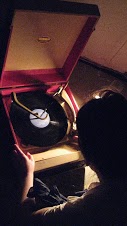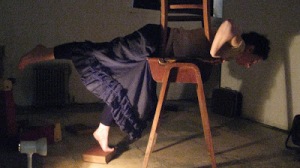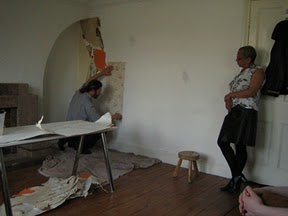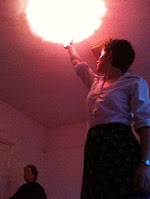How We Collaborate is a project that allows artists to investigate ways we (can) collaborate when we make performance work together; perhaps there are strategies, new approaches and lessons we can learn from each other. Two artists make a piece in response to the previous link in the chain. Residence provides artists with a weeks worth of space (at The Milk Bar) to make their work and a space to perform/share the results, as well as a space for a discussion event around their experiences. The discussion is accompanied (/facilitated by!) tea and cake. This is an informal open event, if you would like to join us for the next “HOW WE COLLABORATE” please email info(at)residence.org.uk
The Rules:
1. 2 People (New Or Existing Collaboration) Make A New Piece Or Pieces
2. Find A Strategy For Collaboration
3. The Piece Or Pieces Must Respond To The Previous Piece
4. Show The New Piece In One Month’s Time With Accompanying Cake, Tea And Discussion
5. You May Benefit From Optional Consultation With The Previous Collaboration
The Back-story: Initially Lucy and Martha wanted to push at and explore the way they make work together. They decided to spend a week making two pieces in response to the piece of work they were developing together. But rather than just “muck in” they wanted to be specific and thoughtful about how they could make the best of their collaboration (rather than compromise and come to an (un)happy medium). They decided to approach the week with a specific rules set about how the work would be made, and titled the method “in conversation’. They invited Residence members and a few other artists to join them.
HOW WE COLLABORATE: ONE
Sunday 13th December 2009 at 3pm
Collaborating Pair: Lucy Cassidy and Martha King
Attendees: Saini, Duncan, Annelies, Jess, Jo, Mel, Tanuja, Gemma, James, John, Tim, Alice, Elaine. Derek and Ed
Method of Collaboration: In Conversation (1. Present and talk about ‘your’ piece to the other, listen to their feedback and have a conversation about the work and its development (repeat for your partner’s piece) 2. Work alone on the piece for a set amount of time. 3. Come back together and repeat stage one).
HOW WE COLLABORATE: TWO
Monday 25th January 2010 at 7pm
Collaborating Pair: Jessie and Annelies Puddy
“I remember four kettles on the floor all boiling simultaneously with their lids open. I remember it sounding like thunder, like a roaring train and like the sea. I remember Jessie holding her face too long over a boiling kettle and her flushed pink steamed face. I remember waiting for a long time for a kettle to boil and when it did I remember a sudden loud drop to the floor. I remember Jessie and Annelies’ bodies in broken looking positions on the floorboards. I remember Annelies snailing her finger along a windowsill and talking about walking along the edge of a razor blade. I remember conversations about chaos theory.” (Lucy Cassidy)
HOW WE COLLABORATE: THREE
Collaborating Pair: Jo Bannon and Mel Shearsmith
Monday 12th March 2010 at The Milk Bar
Process
Mel:
We began by agreeing to respond to the second ‘How we collaborate’ despite and because Jo had been present at Annalies’s and Jess’s performance and I had been absent. We agreed to make this a feature to begin our collaborative process. How might we go about responding when one of us had not been present?
I proposed to ask all those who had been present to send me some thoughts, rememberances, recollections. I sent the audience questions based on the first performance by Martha and Lucy and was struck by how their responses resonated with my recollections of the first performance. There was a sense of the weather, the physicality of the bodies, strange, unexpected clarity of positions and an edge (a knife, boiling steam) that brought the images of ice and the danger of a real cliff edge (or edge of the room) back to my mind.
I became a collector of recollections.
I then began to form a (written) response to their rememberings – this creative response (a call and response) was inspired by Goat Islands Creative Response. We would, in turn respond to each other, Jo and I. We had given ourselves deadlines so we would receive and send a ‘response’ pretty much on a weekly basis. There were unintentional links in our thoughts, similarities or a sense of space/place and small stories that started to take root there:
I would like to live in the open air and sometimes I would.
It is a mystery
In a room
Melancholy writing itself
I cannot see well:
Still broken bodies,
Ruined mannequin limbs lying at odd angles
A train wreck and the call of the sea.
I saw her walking along the windowsill
A tightrope walking (around her neck)
I’m thinking of die-ing slowly
While hunched over the toilet
A room of Small Chaos.
These wordful wanderings led us around each other, circling in closer and closer to some sense of the space, the atmosphere, the intention or the meaning that we were digging for. We picked, fondled and chewed over similar thoughts, themes and re-occurances until we recognised the need to get into the space (Residence) and locate the ideas in there.
Jo: I often think of collaborations as courtships, sometimes hot and heavy, sometimes long and languid and sometimes never getting off the ground. This notion of courtship seems apt for the beginning of our process together. Two new bodies tentatively stepping closer, negotiating the territory between us, exploring what this new formula of me plus you could become. Like a long ago romance we have communicated through letters sent by email, each message a hopeful step towards a mutual understanding. A response in your inbox was a gift from the other, a small window into their thoughts, a story opening up between you. We were winding around each other, intertwining, slowly.
Roles
Mel: We agreed our roles; Jo would be dramaturg and I would perform. Clarifying these roles helps to ground the process and we began to work in the space, bringing in objects and actions that reflected our writing and thoughts. The idea of performing alone is terrifying but I need to move, to act, to be in the moment. I want be out of my head and back with my body, in the dark, sensing and not knowing what would happen between us.
Jo: I am the dramaturg and I’m not sure what that means. Europe knows what a dramaturg is and although we have this term in England it is still, for me at least, a little hazy. I think what I mean when I say I am operating in this way is to say that I am working in tandem with the performers, with the performance, but with different concerns. I think of it as a sort of facilitator for the artist and the audience, a way of being slightly outside the work and so offering a different reading, a perhaps wider scope of possibilities as it is not necessarily my concern as to how this thing, whatever it turns out to be, gets realised.
Mainly I take this role because it is like being let loose, set free to be a task master whilst having to stay tuned in to the resonances of the work, all the while trying to look after the audience as they journey through whatever this is we’re making.
Mel is very gracious and takes the fact that we have filled the space with random junk and my commands of her to ‘scale the space’ and ‘make it resonate’ with good humour and gets to work.
Performance
Mel: I am blind, my eyes are closed and I am surprised at how my sense of time (or timelessness) is shifting because of this. I become more intuitively responsive to each lone audience member as they co-exist in the space we have created, both sharing
the dark, the hidden corners of the space, the whispering, the creaking of the old stylus record player, the water dripping down the window, the stairs.
Each visitor shaped a subtly different experience of the space with me: interacting, laughing, cautious, playful, fearful.
Jo: Mel is down in the dusty, dark shopfront with her eyes closed and I am answering the door. Each audience member walks in a little cautious, a little nervous perhaps at what might be about to happen. One by one they are given their instruction and led down to the performance space by me.
The doorbell tings, I answer it and so it goes, a looping sequential time in which I greet people, make tea, explain. But another time is running too. The time of the performance, the exact beat and breath of Mel moving from one book to the next, the loud snap of the suitcase, the hissing record player. I am running in tandem to her, to that space, to this space. I am at times infiltrating that space, on cue craning through a gap in the wall to pour water down into the space. A small interruption. A small nod to the other, to other places.
She has her eyes closed.
She is not there
HOW WE COLLABORATE: FOUR
Monday 17 May 2010 at 4. pm
Collaborating pair: Folake Shoga and Steve Robins
Attendees: Jo Bannon, Lucy Cassidy, Saini Manninen, Tom Marshman, Jacky
Puzey, Mel Shearsmith.Method of collaboration:
Folake: ‘We discussed how to proceed by email. Steve said that one of the striking things for him in Mel and Jo’s performance (How We Collaborate Three) had been the use of the old record player: the evocative nature of the sound it made irrespective of its function of playing music. This was I think the way in for both of us, leading to discussions of objects (things) and the connotations awoken by their use; and about how different qualities of objects are involved in producing memory.’
Steve: ‘Sound as texture made its way finally into the performance but it wasn’t in the process something that we concentrated upon much, odd then that it made such a central intervention!’
Folake: ‘We also discussed whether to develop a cut-and-dried methodology for the project.’
Steve: ‘We aimed to interrogate objects through various means, sometimes as a discussion, sometimes though writing, sometimes physically. We varied our tasks and processes to avoid becoming trapped in circular conversations. We came to a shared misunderstanding about objects and their value, by this I mean that we acknowledge the tricky nature of the object, its passing from use to fetish and from fetish to talisman. We thought about families and the retention of memories in objects and their breakage when all who had used an object passed on.’
Folake: ‘We did both suggest some tasks and exercises for both to perform.’
Folake: ‘We both have very different backgrounds, training and experience: we kept the structure of working together deliberately loose, and negotiation between us was continuous’.
Steve: ‘Just to clarify, loose is not the same as “woolly” if there was drifting in our process it was a conscious one, not to get tricked into an easy summation through performance; I was adamant that we shouldn’t fix our ideas too early.’
Folake: ‘However I would say there was not really a methodology apart from using and aspiring towards conversation i.e. an informal give-and-take; and, paradoxically, aspiring towards action rather than words. Since we converse together easily and with pleasure I personally felt a need to be reticent in order not to be led too much by words and the conscious mind.’
Folake: ‘We started with a mutual task: to each go separately to a junk shop and choose an object and make up a back story for it. We then met four times exchanging a mixture of exercises, conversation and small dramatic actions. The fourth meeting was longer and more structured and resulted in the piece we presented for How We Collaborate.’
Steve: ‘To me the performance wasn’t so much a culmination of our conversations as a tangent that one can take but one that can only be taken after chatting for a while about something else! It pleases me to see that the sense of conversation is preserved here in our writing. To me collaborating IS a conversation just one framed in a particular way – I guess you stop collaborating once you haven’t got anything left to “say”. There is still a lot for me and Fol.’
HOW WE COLLABORATE: FIVE
Monday 19 July 2010 at 6 pm
Collaborating pair: Saini Manninen and Helka Manninen

Attendees: Lucy Cassidy, Jo Bannon, Jessie Percival, Hannah Sullivan, Winnie Love, Rod Harris, Tom Marshman, Liz Clarke, Luke Travers, James Dixon, Folake Shoga, Steve Robins
She likes fruit. She eats watermelon. She eats breakfast and salad and chocolate. She chews gum amd presses her lips together so hard she gets an ulcer inside her mouth. She rolls her tongue. She has a scar from when she fell from high above and her teeth went through her lower lip. I’m remembering you.

We are Helka and Saini. We live on the opposite sides of the world. We wanted to work together across continents and time zones. Our collaboration method consisted of having meetings on Skype during weekends and working on our own and using email during the week. The piece as well as our working method was informed by the fact that we are sisters. We aim to continue working together and make a simultaneous performance on two continents.
HOW WE COLLABORATE: SIX
Hannah Sullivan and Joanna Squires
Monday 6th September at 18.00 at Residence, The Milk Bar.
Hannah and Jo had never collaborated like this before. They are friends, housemates and fellow Theatre company members. They created a short piece ‘significant other’ devised over the month. In this process they asked themselves some questions;
– who do you consider to be the closest person to you?
– what do you learn about someone when you spend allot of time with them?
– define the word ‘family’










